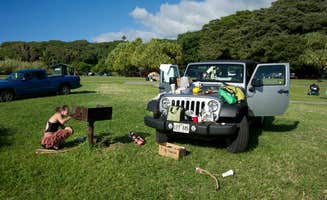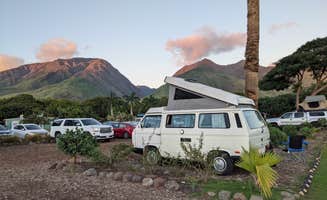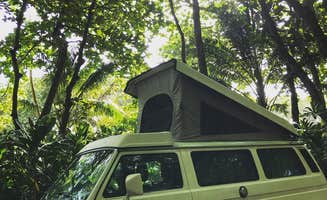Near Kahului, Hawaii, RV camping options provide access to Maui's diverse microclimates, from coastal areas to higher elevations at 7,000 feet. Temperatures can vary dramatically between locations, with mountain sites like those in Haleakalā National Park dropping to 30 degrees at night even during summer months. Campsites throughout the island typically require advance booking, especially during whale-watching season from November to May.
What to do
Hiking trails near campsites: At Hosmer Grove Campground, campers can access the Frankenstein-like nature trail through mixed woods. "The campground is home to a nature trail through a Frankenstein'd woods where they planted numerous different trees after logging the area in the old days searching for a fast growing tree they could then log again," notes Ryan W.
Visit Seven Sacred Pools: Campsites at the Kīpahulu district provide convenient access to famous swimming spots. "My family and I usually camp by the beach where you can fish or swim in the pools. I recommend this campground due to the location, easy access to waterfall hikes and beach front camping," shares Emmanuel M.
Stargazing opportunities: The lack of light pollution at some campgrounds creates excellent conditions for night sky viewing. "Little light pollution, great for star gazing," reports Esther L. about her stay at Camp Olowalu.
Bird watching: Some campsites offer opportunities to view rare Hawaiian bird species. "The bird watching is wild. The confluence of water and mixed plants makes this a perfect spot for bird watching, including some rare and endangered birds," explains Ryan W.
What campers like
Beach proximity: Many campers appreciate direct access to beaches from their sites. "You can see the beach from a few campsites. Like most camping in Hawaii, bring your earplugs for the roosters," advises Valerie S. at Camp Olowalu.
Clean shower facilities: Several campgrounds provide well-maintained washing facilities. "The outdoor showers at Camp Olowalu resort are worth the stay in and of themselves. They are works of art, frankly," notes Shari G.
Affordable camping options: National Park sites offer budget-friendly multiday access. "A National Park pass ($30) here is good for 3 days of camping including sites at Haleakala," explains Shane G. about Kīpahulu Campground.
Early access to popular spots: Staying overnight allows visitors to beat day-trip crowds. "Camping at Kipahulu means that you can hit the trail early before the resort/day visitors make it to this side of the island," Stephanie Z. points out.
What you should know
Weather variability: Mountain sites experience cold temperatures despite Hawaii's tropical location. "When people say it's cold up there, it's COLD. We were there in June, and by nightfall it got to about 30 degrees," warns Jordan T. about camping at Hosmer Grove.
Campsite layouts: Many campgrounds offer limited privacy between sites. "The campground has great spots for whatever you are looking for in your camping trip. The options include open areas to set up next for other people for large groups or along the shore under your own personal hala tree for seclusion," explains Bryce K.
Limited electricity access: Finding power outlets can be challenging. "Literally 8 plugs for a bajillion people causing a massive traffic jam in the mornings and evenings. On the side of the ice house only (not even near campgrounds)," reports Tracy Jo I. at Camp Olowalu.
Sunrise viewing strategies: Alternative viewpoints may offer better experiences than crowded summits. "In one of the guidebooks it recommended skipping the summit and going to one of the other lookout points to watch the sunrise where it's way less crowded," suggests Jordan T.
Tips for camping with families
Arrive early for shoreline spots: Securing better sites requires early arrival. "If you hope to get a site along the shore I recommend you arrive to the park early," advises Bryce K. about Waiʻanapanapa State Park Campground.
Pack for temperature changes: Bring appropriate clothing for temperature drops at higher elevations. "Be prepared with a warm sleeping bag, long sleeves, long pants, socks and maybe a warm hat," recommends Jordan T. for Hosmer Grove camping.
Consider weekday visits: Some campgrounds experience higher noise levels on weekends. "We spent the first night stuck next to a HUGE party that didn't quiet down til late at night. I bet this wouldn't be the same case on a weekday night," notes Jordan T.
Water supply planning: Some sites lack convenient water filling stations. "Note that there's no running water here, so come prepared with water jugs. While there's running water in the bathrooms at the service center, there's no faucet or anything that you could use to fill up a big water jug," explains Jordan T.
Tips from RVers
Site selection for level parking: Some campgrounds have uneven terrain challenging for RVs. "We shared the campground with about four other groups the night we stayed, and there were only 2 vans camping out. The grassy area to camp on is not completely flat, and unfortunately we chose a spot that was on a bit of an incline and struggled to not slide the whole night," reports Jordan T. about Pālāʻau State Park Campground.
Camper van parking areas: Understand the parking layout before arrival. "We stayed in the camper van area, and while there was plenty of room and a nice picnic table, but it was exactly like camping on the perimeter of a large parking lot," shares Shari G.
Stock up before remote locations: Limited services require advance preparation. "Note that this campground is pretty far away from the closest town so you'll want to be sure you're all stocked up on fuel, water, and all the things you need when you pass through Hana," advises Stephanie Z.
Wind protection strategies: Exposed camping areas may experience high winds. "Because it's open air with no shielding trees, sooo many people evacuated to sleep in cars or resigned to/woke up to collapsed tents because of high winds," warns Tracy Jo I.




